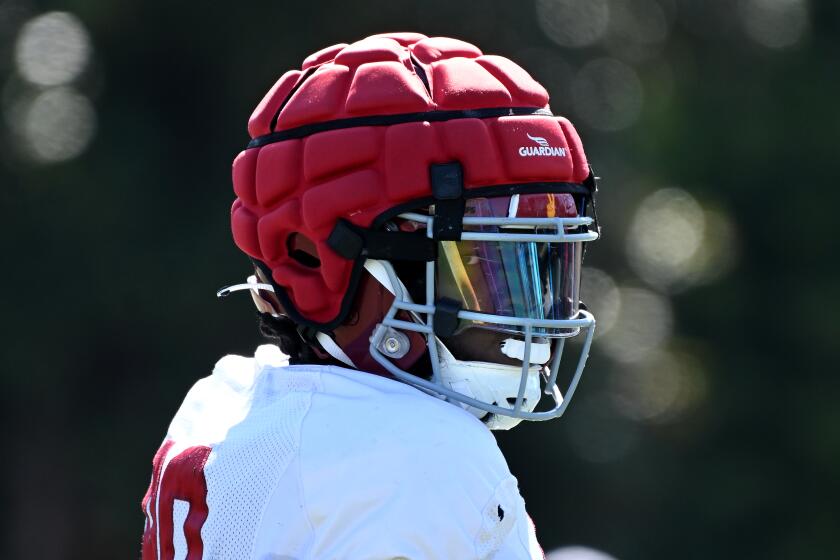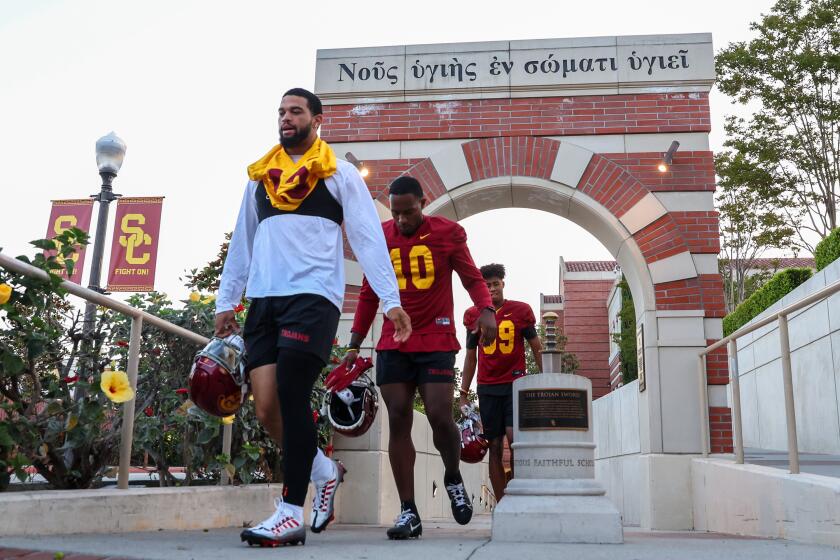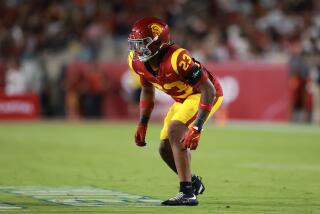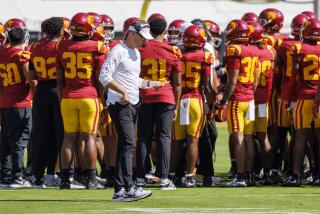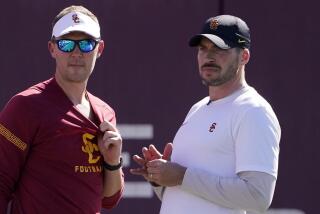USC’s offense should be playoff-worthy. This is what the defense has done to match it
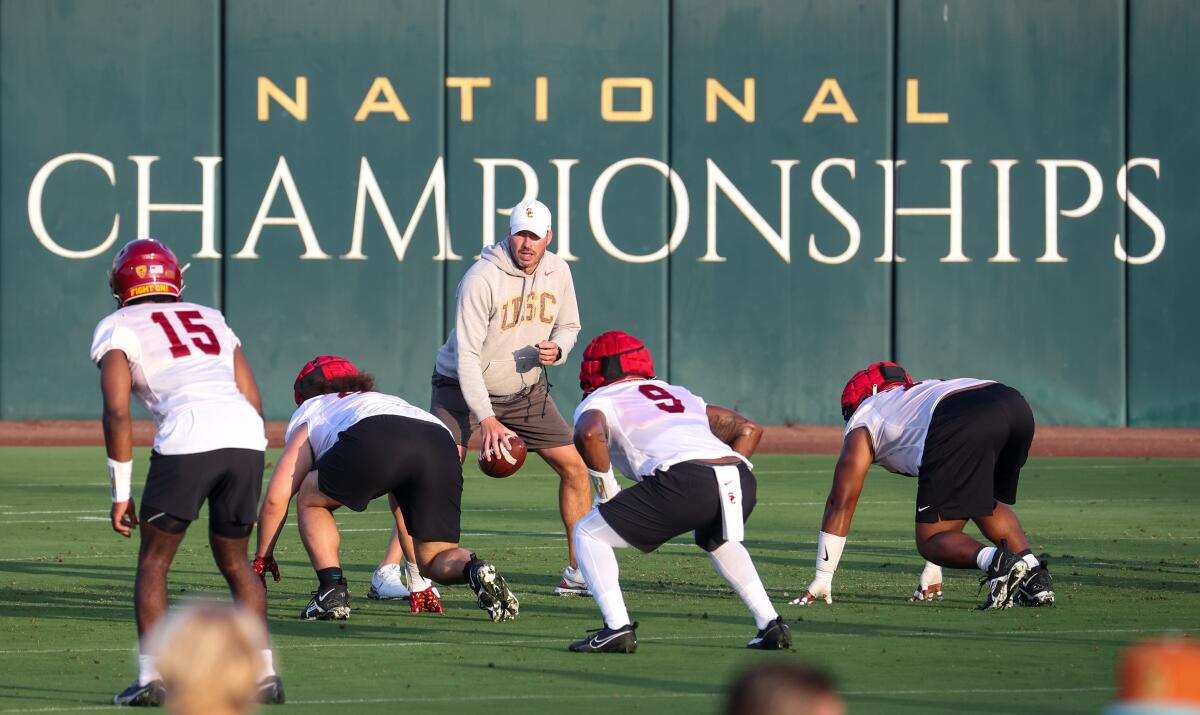
- Share via
It starts with the quarterback. USC’s season won’t be complete if it ends with Caleb Williams as the only star.
With the reigning Heisman winner returning for his second year at USC, the sixth-ranked Trojans are expected to soar. Just how high will depend on a defense that, after last year’s disappointing finish, has a point to prove.
While USC set school records in passing yards and passes attempted in a season, helping Williams hoist the program’s nation-leading eighth Heisman Trophy, the defense was historic in the opposite way.
The 6.53 yards allowed per play were the most given up by a USC defense during a season. The 29.2 points surrendered per game were third-worst in program history.
But with offenses improving rapidly in modern college football, even the best defenses concede big numbers. Before dominating Texas Christian in the national championship game, two-time defending champion Georgia gave up 41 points in a semifinal against Ohio State, USC coach Lincoln Riley noted at Pac-12 media day.
“The old adage of ‘offense wins games, defenses wins championships,’ I don’t think it’s as cut and dry as that anymore,” Pac-12 Networks analyst Yogi Roth said.
With offenses dominating, what is the baseline for a successful defense that can keep the Trojans on track for the College Football Playoff semifinals?
A team that can do both
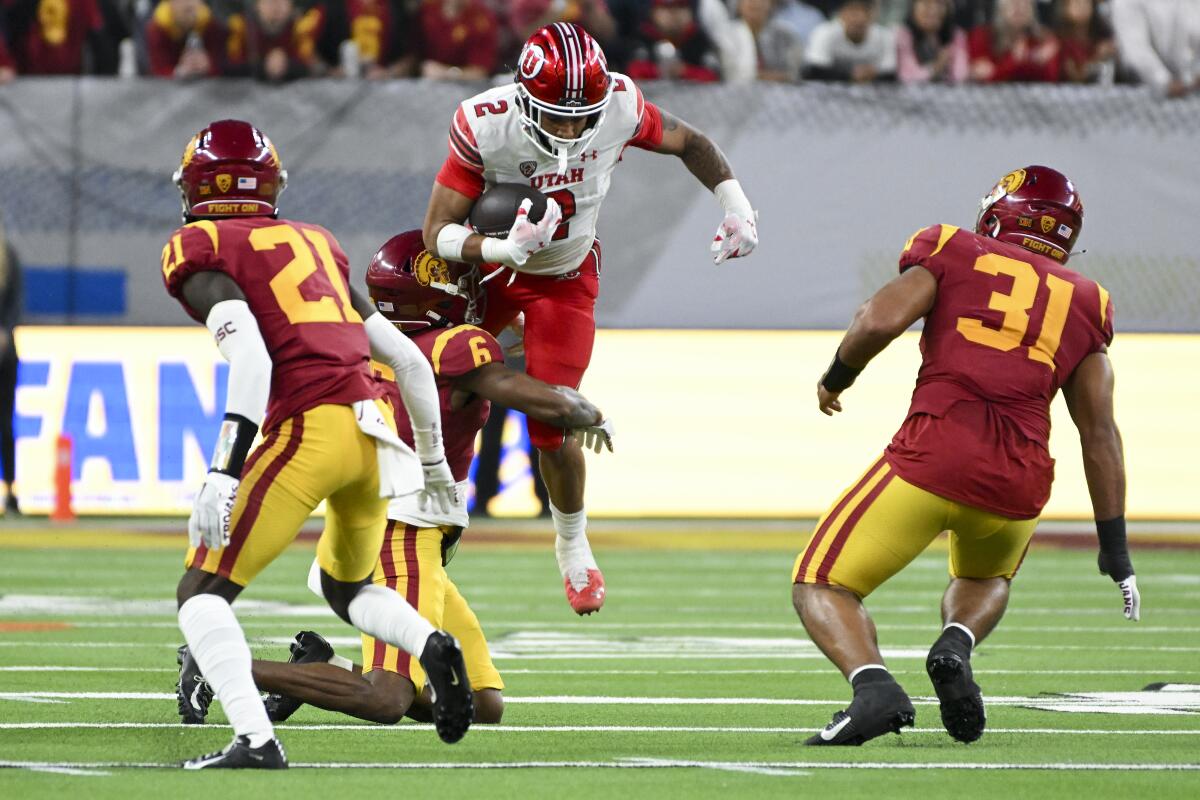
Although the Trojans were the preseason pick to win the Pac-12 championship, they’re still chasing Utah on the field. The Utes are two-time defending conference champions and were the only Pac-12 team to beat USC last year, doing so twice. They combined the stout defense coach Kyle Whittingham has made his trademark with an offense that scored more than 40 points in each critical win.
While defense may feel devalued in this era of high-flying offenses, it still sets a critical tone for a team, Roth said.
“You need to have a mentality that is still an old-school defensive approach,” Roth said. “We’re going to be physical, when you come play us, you’re going to walk out of here and you’re going to be sore. You’re going to be a tough out. That’s what Utah is.”
Whittingham, the longest-tenured coach in the Pac-12, estimated at media day that today college football games are determined 50% by offense, 35% by defense and 15% by special teams.
Riley’s teams have proven they can take care of the largest part of the assignment. His offenses were ranked in the top six nationally in scoring and in the top three in total yardage during each of his College Football Playoff semifinal appearances at Oklahoma. During Kyler Murray’s Heisman-winning campaign in 2018, the record-setting offense was dynamic enough to drag a scoring defense ranked 101st in the country into the playoff, where the Sooners lost to Alabama in the semifinal.
It’s unlikely many offenses could carry such heavy loads on the way back to the playoff. Until TCU last season, the 2018 Sooners were the only semifinal team in the CFP era whose scoring defense was worse than the national average. The Horned Frogs gave up 29 points per game, which ranked 89th nationally and was the second most for a playoff team after Riley’s 2018 Sooners.
USC’s scoring defense ranked 93rd in the country.
Bear Alexander overcame an unstable home with the help of mentor Tony Jones. After many stops, Alexander is expected to help improve the USC defense.
Deliver in crunch time
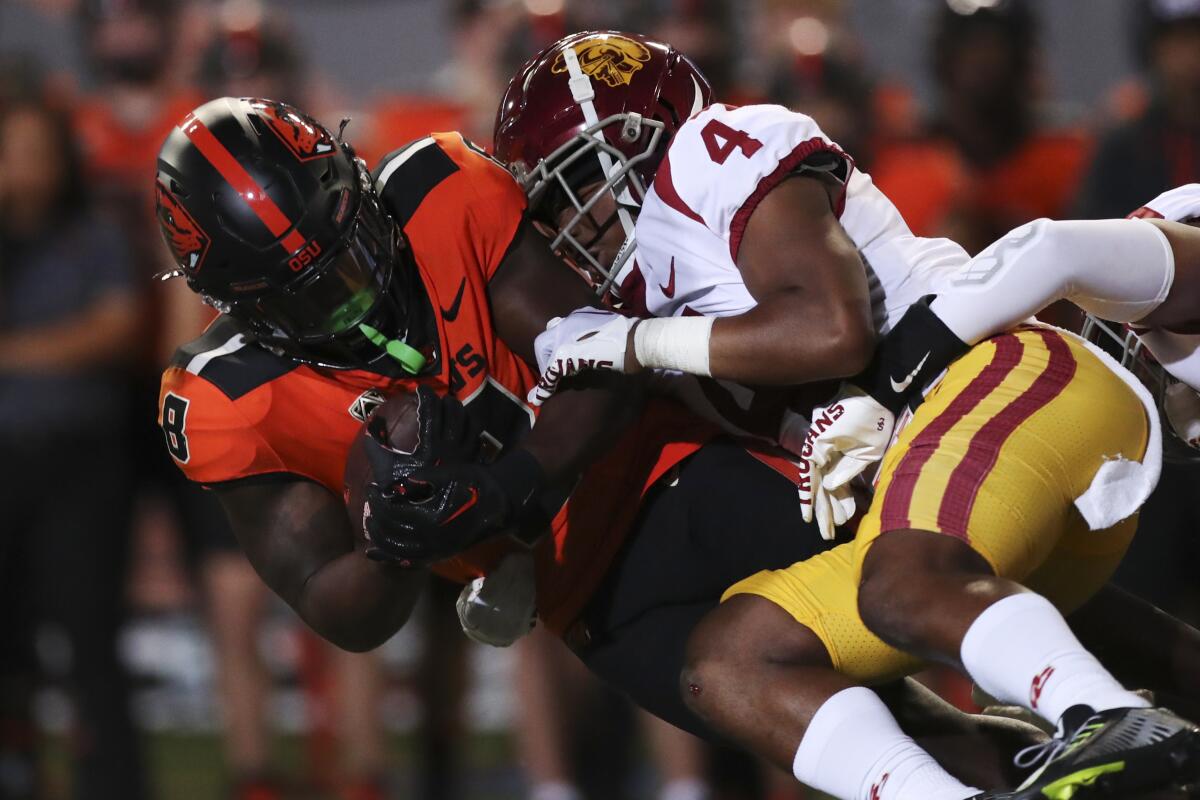
Despite having the lowest-ranked offense and defense for a playoff team last season, TCU boasted the most important number: zero regular-season losses. An opportunistic defense and the heroics of Heisman-finalist quarterback Max Duggan helped the Horned Frogs win four one-possession games to stay in the playoff race, a possible blueprint for Riley’s team that hopes to become the first Pac-12 team to make the cut since 2016.
“Are you going to hold every single team to 10 points [in] this day and age? Maybe not right now,” Riley told reporters at media day. “Are you impacting winning? Are you making that consistent impact on a week-to-week basis? I think that’s what tells the story. … The best teams, I think, have groups on all sides of the ball that are able to persevere and really show up in the big moments.”
USC wilted at critical times last year. The Trojans gave up 35.7% of their points during the fourth quarter, the only period in which their offense was outscored by opponents. They gave up 14-point leads in each of their three losses.
While some pinned the struggles on the lack of defensive depth, especially late in the season as injuries piled up, safety Max Williams, who started 13 games last year, didn’t duck responsibility.
“It was probably more so mind issues,” the Gardena Serra alumnus said. “Guys probably thinking about what to do after the game or when the game’s going to be over and not really focusing on the task at hand. That’s really something we put an emphasis on at camp.”
Spring and preseason practices sometimes stretched for three hours, with an expectation to maintain the energy throughout. The team emphasized long drives during practices to simulate game situations.
Coaches and players were encouraged by the scripted dress rehearsals, but they know what needs to come next.
“You have to go do it on Saturday,” defensive coordinator Alex Grinch said.
USC wrapped fall camp this week, with all eyes on its season opener against San Jose State. Here’s what you need to know from the final days of camp.
Chaos ball
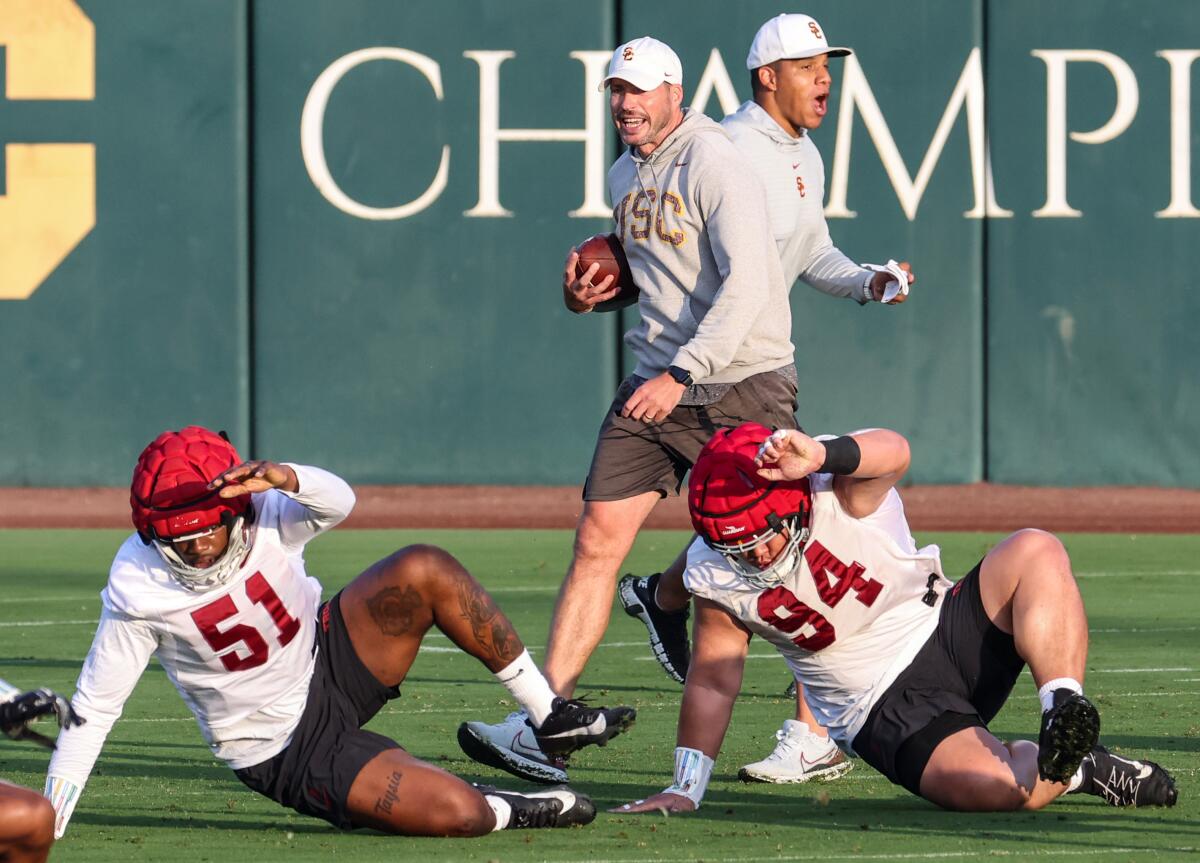
Grinch, who followed Riley to USC from Oklahoma, was under fire as the defensive struggles became a seasonlong thorn. The coach didn’t waver about retaining the 43-year-old coordinator, whose resume includes successful turnarounds at Washington State and Oklahoma.
Grinch built his previous defenses on creating havoc, Roth said. There was a “game wrecker” at rush end to cause chaos in the backfield. An NFL-caliber defensive back locked down part of the field against the passing game. Athletic linebackers who can run. USC can check the boxes.
“You look at this defense, it’s built like that,” Roth said. “It has to be proven.”
USC had one star on the defensive line last year as unanimous All-American Tuli Tuipulotu racked up 22 tackles for loss and 13½ sacks. But no other player reached double digits in tackles for loss, falling well short of Grinch’s most successful defense at Washington State that had three players with 11 or more. The 2017 Cougars had 103 tackles for loss compared to USC’s 79 last year.
The defensive line room is restocked with options who can close the gap after the coaching staff raided the transfer portal. With newcomers Jamil Muhammad (Georgia State), Bear Alexander (Georgia), Anthony Lucas (Wyoming) and Kyon Barrs (Arizona), the defensive front is “just ferocious,” Max Williams said.
After last year’s struggles, the redshirt senior isn’t concerned about quieting critics who have dismissed the defense as a liability. Going toe-to-toe against the one of the best offenses in the country every day is enough to show Williams what the Trojans can grow into this year.
“It’s not just all about the offense,” he said. “We want to be known for our defense as well.”
More to Read
Go beyond the scoreboard
Get the latest on L.A.'s teams in the daily Sports Report newsletter.
You may occasionally receive promotional content from the Los Angeles Times.

